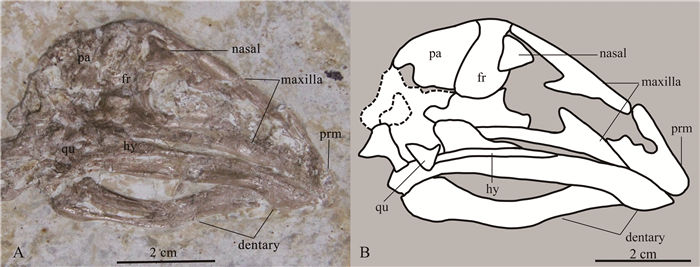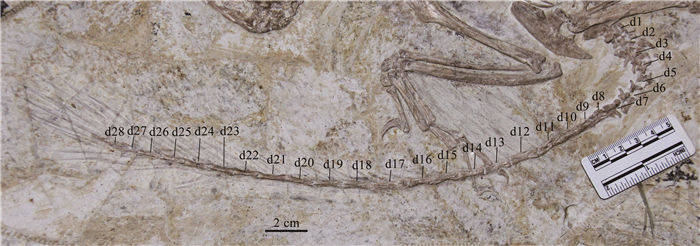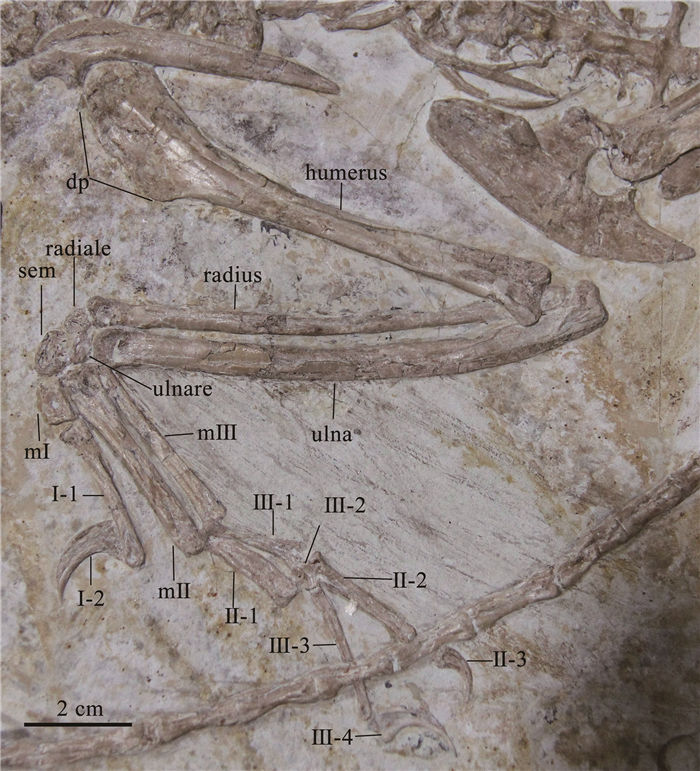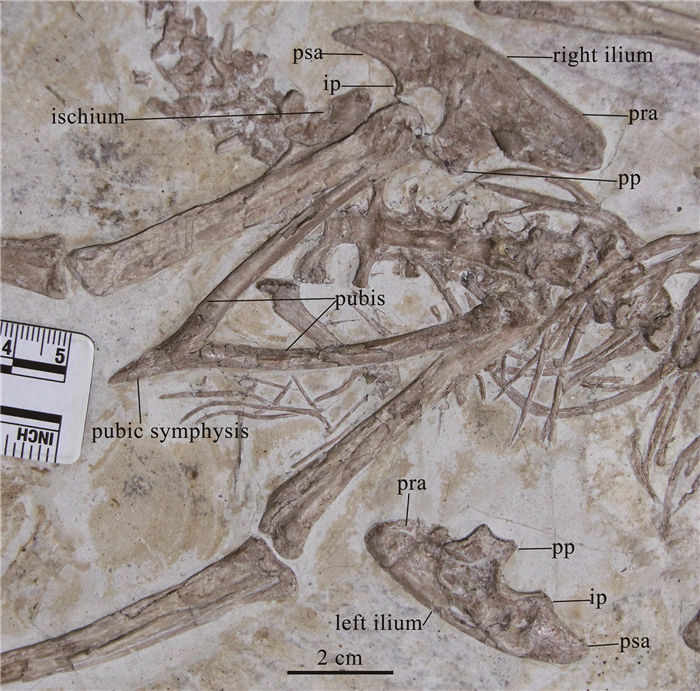A new jeholornithiform identified from the Early Cretaceous Jiufotang Formation in western Liaoning
-
摘要:
辽宁朝阳早白垩世九佛堂组发现了一种新型热河鸟类化石。该化石不仅具有热河鸟类的典型特征,如尾椎由约28枚未愈合的椎体组成,中后部尾椎前后方向明显拉长;前颌骨无牙齿;齿骨后缘较直,靠近吻端腹侧明显膨大等,同时具有不同于其他已知热河鸟类的独具特征组合,如肱骨三角肌脊相对不发育;第三掌骨较直,与第二掌骨间距较小;后肢第一趾爪最大;尾椎脉弧、关节突不发育等。根据该化石的独特性及与其他热河鸟类特征对比研究,笔者建立了热河鸟类新属、新种:直掌内蒙鸟(Neimengornis rectusmim gen.et sp.nov.)。直掌内蒙鸟(新属、新种)的发现进一步丰富了热河鸟类的属种类群,为研究这一类群的形态特征和属种分异等提供了新的化石证据。
Abstract:A new specimen of jeholornithiform was identified from the Early Cretaceous Jiufotang Formation in Chaoyang of Liaoning Province.This specimen shows typical characters of Jeholornithiformes, such as the long bony tail composed of about 28 free caudal vertebrae, the middle and posterior caudal vertebrae elongated antero-posteriorly, the edentulous premaxilla, and the dentary with a straight ventral margin posteriorly and a robust anterior end expanded ventrally.It differs from all other jeholornithiforms in the following unique combination of features: the relatively undeveloped deltopectoral crest of the humerus, the straight third metacarpal, which forming a small gap with the second metacarpal, the largest hallux ungula, and the undeveloped chevrons and zygapophyses of the caudal vertebrae.On the basis of unique characteristics and comparisons with other jeholornithiforms, a new genus and species(Neimengornis rectusmim gen.et sp.nov.) were erected.The identification of Neimengornis rectusmim further enriches the diversity of jeholornithiforms and sheds new light on understanding the morphology and classification of this clade.
-
Key words:
- Jehol Biota /
- Early Cretaceous /
- western Liaoning /
- jeholornithiformes
-

-
表 1 直掌内蒙鸟(Neimengornis rectusmim gen.et sp.nov.)模式标本主要骨骼测量数值
Table 1. Measurements of main bones of the holotype of Neimengornis rectusmim gen.et sp.nov.
骨骼名称 测量值/mm 骨骼名称 测量值/mm 头骨长 67 胫骨长(r) 90 头骨高 31 腓骨长(l) 77.4 肩胛骨长(r) 55.8 跗跖骨长(r) 43.6 叉骨支长 19.4 第一跖骨长(r) 5.6* 肱骨长(r) 89 第二跖骨长(r) 42.5 尺骨长(r) 88 第三跖骨长(r) 43.6 桡骨长(r) 85 第四跖骨长(r) 41.7 掌骨联合长(r) 38.6 第五跖骨长(r) 7* 第一掌骨长(r) 7.4 第一跖第一趾节长(r) 13.2 第二掌骨长(r) 38.6 第一趾爪长(r) 19.6 第三掌骨长(r) 34 第二跖第一趾节长(r) 10.5 第一指第一指节长(r) 27.7 第二跖第二趾节长(r) 12.1 第一指爪长(r) 17.9 第二趾爪长(r) 14.8 第二指第一指节长(r) 17.9 第三跖第一趾节长(r) 12.2 第二指第二指节长(r) 22.8 第三跖第二趾节长(r) 11.3 第二指爪长(r) 10.9 第三跖第三趾节长(r) 11.7 第三指第一指节长(r) 20 第三趾爪长(r) 13.2 第三指第二指节长(r) 4.5 第四跖第一趾节长(r) 9.4 第三指第三指节长(r) 25 第四跖第二趾节长(r) 7 第三指爪长(r) 15.8 第四跖第三趾节长(r) 8.2 肠骨长(r) 53.5 第四跖第四趾节长(r) 9 耻骨长(r) 77.3 第四趾爪长(r) 14.8 耻骨联合长 21.5 前后肢长度比(r) 1.09 股骨长(r) 74 注:*表示该骨骼保存长度,r代表右侧骨骼,l代表左侧骨骼 -
[1] Walker C A. New subclass of birds from the Cretaceous of South America[J]. Nature, 1981, 292(5818): 51-53. doi: 10.1038/292051a0
[2] 王旭日, 季强, 滕芳芳, 等. 中国辽宁义县早白垩世燕鸟一新种[J]. 地质通报, 2013, 32(4): 601-606. doi: 10.3969/j.issn.1671-2552.2013.04.008 http://dzhtb.cgs.cn/gbc/ch/reader/view_abstract.aspx?file_no=20130408&flag=1
[3] Dalsätt J, Ericson G P, Zhou Z. A new Enantiornithes(Aves) from the Early Cretaceous of China[J]. Acta Geologica Sinica, 2014, 88(4): 1034-1040. doi: 10.1111/1755-6724.12270
[4] Wang M, Liu D. Taxonomical reappraisal of Cathayornithidae(Aves: Enantiornithes)[J]. Journal of Systematic Palaeontology, 2016, 14(1): 29-47. doi: 10.1080/14772019.2014.994087
[5] 牛绍武, 辛后田. 冀北滦平盆地九佛堂组-沙海组叶肢介化石的发现与陆相建阶问题的讨论[J]. 地质通报, 2018, 37(10): 1801-1819. http://dzhtb.cgs.cn/gbc/ch/reader/view_abstract.aspx?file_no=20181006&flag=1
[6] 陈刚, 张晓明, 杨桂芳, 等. 辽西地区下白垩统九佛堂组沉积与有机质发育特征[J]. 地质通报, 2019, 38(2/3): 426-436. http://dzhtb.cgs.cn/gbc/ch/reader/view_abstract.aspx?file_no=2019020323&flag=1
[7] Wang X R, Chiappe L M, Teng F, et al. Xinghaiornis lini(Aves: Ornithothoraces) from the Early Cretaceous of Liaoning: an example of evolutionary mosaic in early birds[J]. Acta Geologica Sinica, 2013, 87(3): 686-689. doi: 10.1111/1755-6724.12080
[8] Kundrát M, Nudds J, Kear B P, et al. The first specimen ofArchaeopteryx from the Upper Jurassic Mörnsheim Formation of Germany[J]. Historical Biology, 2019, 31: 3-63. doi: 10.1080/08912963.2018.1518443
[9] Wang M, Zhou Z. A new Enantiornithine(Aves: Ornithothoraces) with completely fused premaxillae from the Early Cretaceous of China[J]. Journal of Systematic Palaeontology, 2019, 17(15): 1299-1312. doi: 10.1080/14772019.2018.1527403
[10] Xu X, Zhou Z, Wang Y, et al. Study on the Jehol Biota: recent advances and future prospects[J]. Science China(Earth Sciences), 2020, 63(6): 757-773. doi: 10.1007/s11430-019-9509-3
[11] 季强, 姬书安, 尤海鲁, 等. 中国首次发现会飞的"恐龙"——中华神州鸟(新属新种)[J]. 地质通报, 2002, 21(7): 364-369. http://dzhtb.cgs.cn/gbc/ch/reader/view_abstract.aspx?file_no=20020797&flag=1
[12] Zhou Z H, Zhang F C. A long-tailed, seed-eating bird from the Early Cretaceous of China[J]. Nature, 2002, 418(6896): 405-409. doi: 10.1038/nature00930
[13] 季强, 姬书安, 张鸿斌, 等. 辽宁北票首次发现初鸟类化石——东方吉祥鸟[J]. 南京大学学报(自然科学), 2002, 38(6): 723-736. https://www.cnki.com.cn/Article/CJFDTOTAL-NJDZ200206000.htm
[14] Ji Q, Ji S A, You H L, et al. An early Cretaceous avialan bird, Shenzhouraptor sinensis from Western Liaoning, China[J]. Acta Geologica Sinica, 2003, 77(1): 21-25. http://www.onacademic.com/detail/journal_1000035574429110_3b8d.html
[15] Zhou Z H, Zhang F C. Jeholornis compared to Archaeopteryx, with a new understanding of the earliest avian evolution[J]. Naturwissenschaften, 2003, 90(5): 220-225. doi: 10.1007/s00114-003-0416-5
[16] 高春玲, 刘金远. 辽西早白垩世九佛堂组一新的初鸟类[J]. 世界地质, 2005, 24(4): 313-318. doi: 10.3969/j.issn.1004-5589.2005.04.001
[17] Zhou Z H, Zhang F C. Mesozoic birds of China-a synoptic review[J]. Frontiers of Biology in China, 2007, 2(1): 1-14. doi: 10.1007/s11515-007-0001-y
[18] Li D S, Corwin S, Zhou Z H, et al. Basal birds from China: a brief review[J]. Chinese Birds, 2010, 1(2): 83-96. doi: 10.5122/cbirds.2010.0002
[19] O'Connor J K, Sun C K, Xu X, et al. A new species of Jeholornis with complete caudal integument[J]. Histological Biology, 2012, 24(1): 29-41. doi: 10.1080/08912963.2011.552720
[20] Lefévre U, Hu D Y, Escuillie F, et al. A new long-tailed basal bird from the Early Cretaceous of northeastern China[J]. Biological Journal of the Linnean Society, 2014, 113: 790-804. doi: 10.1111/bij.12343
[21] Chiappe L M, Ji S A, Ji Q, et al. Anatomy and systematics of the Confuciusornithidae(Theropoda, Aves) from the late Mesozoic of northeastern China[J]. Bulletin of the American Museum of Natural History, 1999, 242: 3-90.
[22] Peters W S, Peters D S. Sexual size dimorphism is the most consistent explanation for the body size spectrum of Confuciusornis sanctus[J]. Biology Letters, 2010, 6: 531-532. doi: 10.1098/rsbl.2010.0173
[23] Jesús M L, Chiappe L M, Ji S A, et al. Quantitative patterns of morphological variation in the appendicular skeleton of the Early Cretaceous bird Confuciusornis[J]. Journal of Systematic Palaeontology, 2011, 9(1): 91-101. doi: 10.1080/14772019.2010.517786
[24] Lü J C, Unwin D M, Deeming D C, et al. An egg-adult association, gender, and reproduction in pterosaurs[J]. Science, 2011, 331: 321-324. doi: 10.1126/science.1197323
[25] 王旭日, 季燕南, 黑须球子, 等. 四翼恐龙还是恐龙的性双形现象[J]. 地质学刊, 2016, 40(1): 1-6. doi: 10.3969/j.issn.1674-3636.2016.01.1
[26] Zheng X T, O'Connor J K, Huchzermeyer F W, et al. Exceptional preservation of ovarian follicles in Early Cretaceous birds and implications for early evolution of avian reproductive behavior[J]. Nature, 2013, 495: 507-511. doi: 10.1038/nature11985
[27] Chinsamy A, Chiappe L M, Marugán-Lobón J, et al. Gender identification of the Mesozoic bird Confuciusornis sanctus. Nature Communications, 2013, 4(1381): 1-5. http://www.nature.com/articles/ncomms2377.pdf
[28] O'Connor J K, Wang M, Zheng X T, et al. The histology of two female Early Cretaceous birds[J]. Vertebrata Palasiatica, 2014, 52: 112-128.
[29] O'Connor J K, Erickson G M, Norell M, et al. Medullary bone in an Early Cretaceous enantiornithine bird and discussion regarding its identification in fossils[J]. Nature Communications, 2018, 9(5169): 1-8. http://www.onacademic.com/detail/journal_1000041601541199_6c72.html
[30] Chiappe L M, Ji S A, Ji Q. Juvenile birds from the Early Cretaceous of China: implications for enantiornithine ontogeny[J]. American Museum Novitates, 2007, (3594): 1-46.
[31] O'Connor J K, Zheng X T, Sullivan C, et al. Evolution and functional significance of derived sternal ossification patterns in ornithothoracine birds[J]. Journal of Evolutionary Biology, 2015, 28: 1550-1567. doi: 10.1111/jeb.12675
[32] Wang M, Li Z H, Zhou Z H. Insight into the growth pattern and bone fusion of basal birds from an Early Cretaceous enantiornithine bird[J]. Proceedings of the National Academy of Sciences, 2017, 14: 11470-11475.
[33] Dana J, Rashid K S, Chiappe L M, et al. Avian tail ontogeny, pygostyle formation, and interpretation of juvenile Mesozoic specimens[J]. Scientific Reports, 2018, 8(9014): 1-12. http://www.nature.com/articles/s41598-018-27336-x.pdf
-



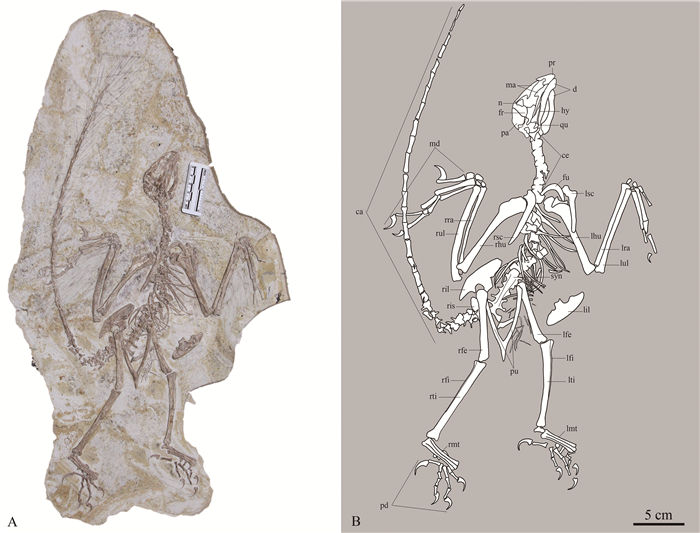
 下载:
下载:
